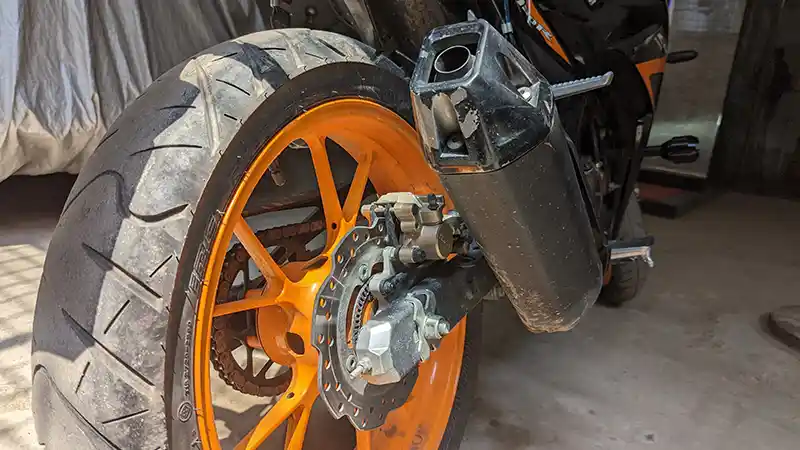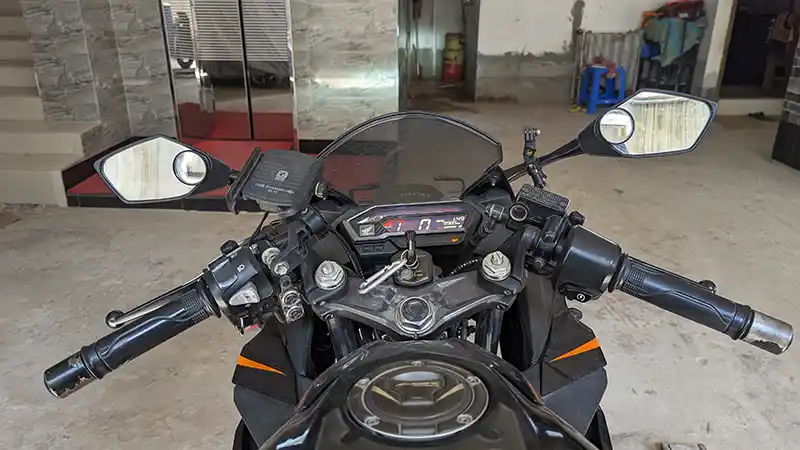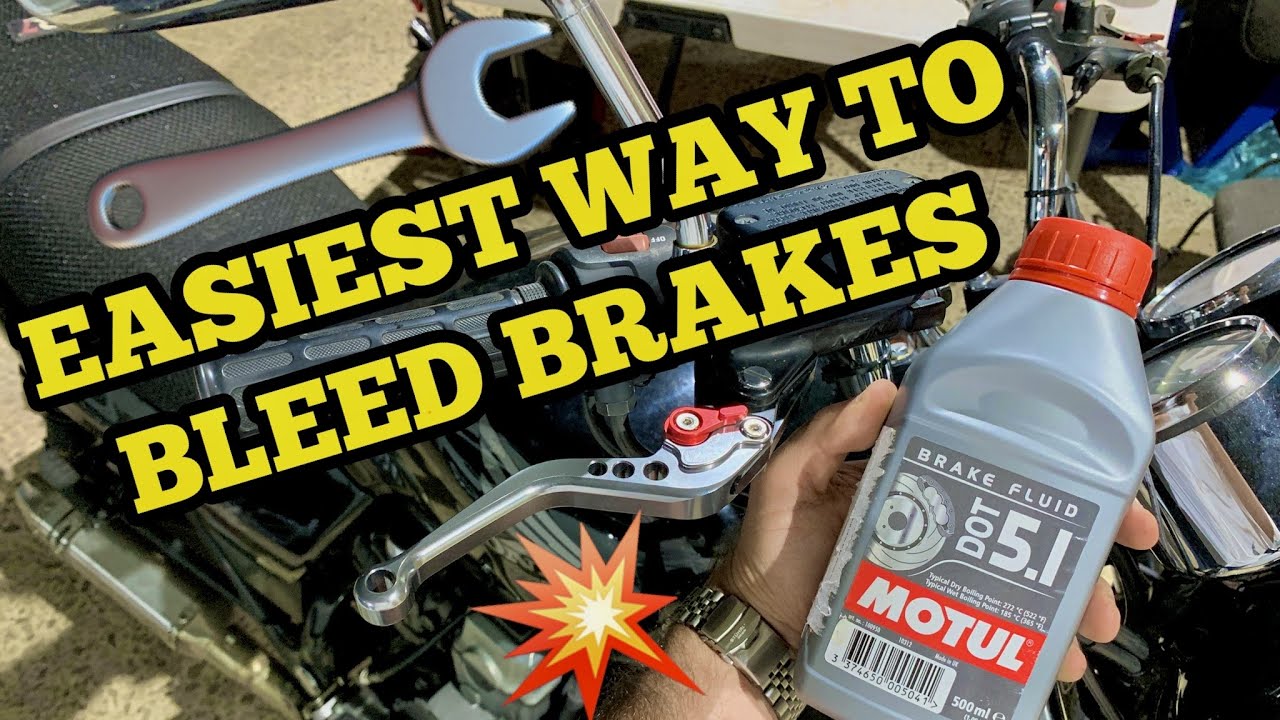Motorcycle’s rear brake works by applying pressure to the brake rotor or drum located on the rear wheel. When the rider applies pressure to the rear brake pedal, the brake pads are pressed against the rotor. This creates friction that slows down the rear wheel and the motorcycle. But sometimes, they may face issues and could be dangerous for safety.
Motorcycle rear brake no pressure means that the brake pedal or lever feels soft or spongy when you press it, and the brake is not effectively slowing down the rear wheel. It happens because of:
- Brake fluid leak
- Air in brake lines
- Worn brake pads or shoes
- Malfunctioning master cylinder
In this piece, let’s look at some common causes of rear brake pressure loss and what you can do to fix it.
Possible Causes And Solutions
The below highlights quick causes and fast solutions to for rear brake pressure related problems.
| Problems | Solutions |
|---|---|
| 1. Brake fluid leak | Check for any signs of leak |
| Repair every identified component leaking. | |
| 2. Air Found In The Hydraulic Or Brake Lines | Perform a brake bleed |
| 3. Low brake fluid level | Add up with high quality fluid. |
| 4. Worn brake pads or shoes | The pads or shoes will need to be replaced. |
| 5. Faulty brake caliper | Replace with a new one |
| 6. Blocked brake line | The line will need to be cleaned or replaced |
| 7. Master cylinder failure | Replace with a new one. |
Why Your Motorcycle Rear Brake Won’t Hold Pressure And Solutions?
This can be a serious safety issue and needs to be addressed immediately. However, Let’s discuss the possible causes and solutions to this problem below.
1. Brake Fluid Leak
Over time, the seals and hoses that make up your brake system can wear out or become damaged, leading to fluid leaks. Also brake fluid can leak out because of corrosion in the master cylinder and loose calipers.
And without sufficient brake fluid, the hydraulic system cannot function properly. Thus, you’ll experience a loss of pressure in your rear brake.
Solution
- Step 1: To check for leaks, start by inspecting the brake lines and connections for signs of fluid leakage.
- Step 2: Look for wet spots, stains, or discoloration on the lines and around the fittings.
- Step 3: If you find any signs of a leak, you’ll need to identify and repair the damaged component or replace it altogether.
- Step 4: Overall, regularly inspect the brake system for leaks, wear, and damage.

2. Air Found In The Hydraulic Or Brake Lines
Air can enter the system through a leak, a faulty master cylinder, or improper bleeding. When air is present in the brake lines, it creates pockets of compression that reduce the force that’s transmitted to the brake pads.
As a result, you’ll notice a spongy feeling when you apply the rear brake lever or pedal, and you’ll just have Bo ft need more pressure to slow down or stop.
Solution
You’ll need to perform a brake bleed to eliminate air from your brake system. This process involves opening the bleed valve on your caliper or drum brake and pumping fresh brake fluid through the system until all the air bubbles are expelled.
Be sure to follow the manufacturer’s instructions and use the correct type of brake fluid for your motorcycle.
Watch this video for further knowledge on this issue.
3. Low Brake Fluid Level
The brake system relies on a specific amount of fluid to create hydraulic pressure that allows the brake pads to engage the rotor and slow down the motorcycle.
When the brake fluid level is low, the rear brake may not have enough pressure to function properly. This can cause the rear brake to feel spongy or completely unresponsive.
Solution
- Check the brake fluid reservoir and add fluid if necessary.
- Ensure to use high-quality brake fluid. Also, change brake fluid every 1-2 years or as recommended by the manufacturer.
4. Worn Brake Pads or Shoes
If the brake pads or shoes on your motorcycle are worn, they may not be able to generate enough friction to slow down the rear wheel effectively. And this is very common that they will wear over time due to frequent use.
Solution
- In this case, the pads or shoes will need to be replaced.
5. Faulty Brake Caliper
The caliper is responsible for applying pressure to the brake pads, which in turn press against the rotor to slow down or stop the wheel.
If the caliper is damaged, worn, or stuck, (caused by warped or bent rotors and worn-out pads) It can reduce the force transmitted to the brake pads. This may lead to a loss of pressure in your rear brake.
Solution
- To check for a faulty caliper, remove the wheel and inspect the components for signs of wear, damage, or corrosion.
- Check the brake pads for uneven wear, and ensure that they move freely within the caliper. If you find any signs of damage or wear, you must replace the component with a new one.

6. Blocked Brake Line
A blocked brake line can occur when something obstructs the flow of brake fluid through the brake lines, which can cause reduced or no braking performance. This can occur due to debris or rust buildup in the line, corrosion, damage to the brake line, and failed brake components.
Solution
- The line will need to be cleaned or replaced to fix this issue.
7. Master Cylinder Failure
The master cylinder is an essential component of a hydraulic brake system, and its failure can lead to a loss of braking ability. The master cylinder converts the force applied to the brake pedal into hydraulic pressure.
This is now transmitted to the brake calipers or wheel cylinders, which then apply the brakes. However, it can malfunction due to wear and tear or due to a manufacturing defect.
Solution
- If the master cylinder is the cause of the problem, it will need to be replaced.
Symptoms of Low Pressure in Motorcycle Rear Brake
Before your motorcycle’s rear brake begins to malfunction, it’ll first show some symptoms, Such as-
- Soft or spongy brake pedal
- Lack of braking power from the rear wheel
- Brake warning light on the dashboard
- Unusual noises when applying the rear brake.
Importance Of The Rear Brake
The rear brake is important for several reasons.
- Firstly, it helps to distribute the braking force between the front and rear wheels, which can improve stability and control during braking.
- Secondly, it can be used to slow down or stop the motorcycle when the front wheel is off the ground, such as during wheelies or stoppies.
- Again, it can be used to help control the speed of the motorcycle when riding on steep or slippery surfaces or in low-traction conditions.
FAQs
Questions people also ask about motorcycle rear brake pressure and quick answers to them.
Q: Can you drive with low brake pressure?
Yes, you can. But it’s best to fix the low brake pressure problem once you discover it to ride safely.
Q: What will be the cause of a dropping brake pedal with no fluid loss from the system?
It is caused by an internally leaking defective brake master cylinder
Q: Can you ride a motorcycle without rear brakes?
Yes, you can. But this is not a good idea. Ensure everything is working properly before you hit the road.
Conclusion
Several factors, including a leak in the hydraulic system, the air in the brake lines, etc., can cause a loss of pressure in your motorcycle’s rear brake. Understanding these common causes will help you to take the necessary steps to diagnose and repair the problem.
Also, ensure your motorcycle’s rear brake always functions at its best. If you’re not comfortable performing these tasks yourself, be sure to take your motorcycle to a qualified mechanic who can help you get back on the road safely
